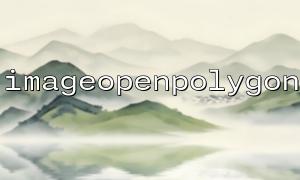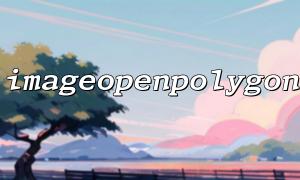Adding shadow effects to polygon shapes is a common requirement in image processing. PHP offers a powerful library of graphic functions, and the imageopenpolygon() function is used to draw polygons. With a few simple techniques, we can add shadow effects to these polygons, enhancing their three-dimensional appearance.
In PHP, the imageopenpolygon() function is used to create a polygon. This function allows you to define the vertices of the polygon and draw it onto an image resource. Its basic syntax is as follows:
imageopenpolygon($image, $points, $num_points, $color);
$image: The image resource.
$points: An array containing the coordinates of all the polygon vertices.
$num_points: The number of vertices of the polygon.
$color: The color of the polygon.
This function allows you to draw polygons of various shapes, and to add shadow effects to them, additional steps are required.
Create the image resource: First, we need to create an image resource.
Draw the polygon: Use the imageopenpolygon() function to draw the polygon.
Draw the shadow: Offset the shadow slightly and fill it with a darker color to make it appear as a reflection of the light source.
Merge the layers: Combine the shadow and polygon to achieve the desired visual effect.
Here’s an example code for implementing this process:
<?php
// Create the image resource
$image = imagecreatetruecolor(400, 400);
<p>// Allocate colors<br>
$white = imagecolorallocate($image, 255, 255, 255);<br>
$black = imagecolorallocate($image, 0, 0, 0);<br>
$shadowColor = imagecolorallocate($image, 100, 100, 100); // Shadow color</p>
<p>// Fill background color<br>
imagefill($image, 0, 0, $white);</p>
<p>// Define polygon vertices<br>
$points = [<br>
100, 100, // Vertex 1<br>
200, 50, // Vertex 2<br>
300, 150, // Vertex 3<br>
250, 250, // Vertex 4<br>
150, 200 // Vertex 5<br>
];</p>
<p>// Draw the shadow (offset by a small distance)<br>
$shadowOffsetX = 10;<br>
$shadowOffsetY = 10;<br>
$shadowPoints = [];<br>
foreach ($points as $key => $value) {<br>
if ($key % 2 == 0) {<br>
$shadowPoints[] = $value + $shadowOffsetX; // Offset x-coordinate<br>
} else {<br data-is-only-node="">
$shadowPoints[] = $value + $shadowOffsetY; // Offset y-coordinate<br>
}<br>
}</p>
<p>// Draw the shadow<br>
imageopenpolygon($image, $shadowPoints, count($shadowPoints) / 2, $shadowColor);</p>
<p>// Draw the polygon<br>
imageopenpolygon($image, $points, count($points) / 2, $black);</p>
<p>// Output the image to the browser<br>
header("Content-Type: image/png");<br>
imagepng($image);</p>
<p>// Destroy the image resource<br>
imagedestroy($image);<br>
?><br>
Create the image resource: We use imagecreatetruecolor() to create a 400x400 image resource and allocate colors (white, black, and shadow color) for it.
Define the polygon vertices: We define a polygon with five vertices, and the vertex coordinates are stored in the $points array.
Draw the shadow: By slightly offsetting each vertex of the polygon, we obtain the shadow's vertex coordinates. The shadow offset is controlled by $shadowOffsetX and $shadowOffsetY.
Draw the polygon: We use the imageopenpolygon() function to draw the shadow and the polygon. The shadow is slightly offset, making it look three-dimensional.
Output the image: Finally, we use the imagepng() function to output the generated image to the browser.














